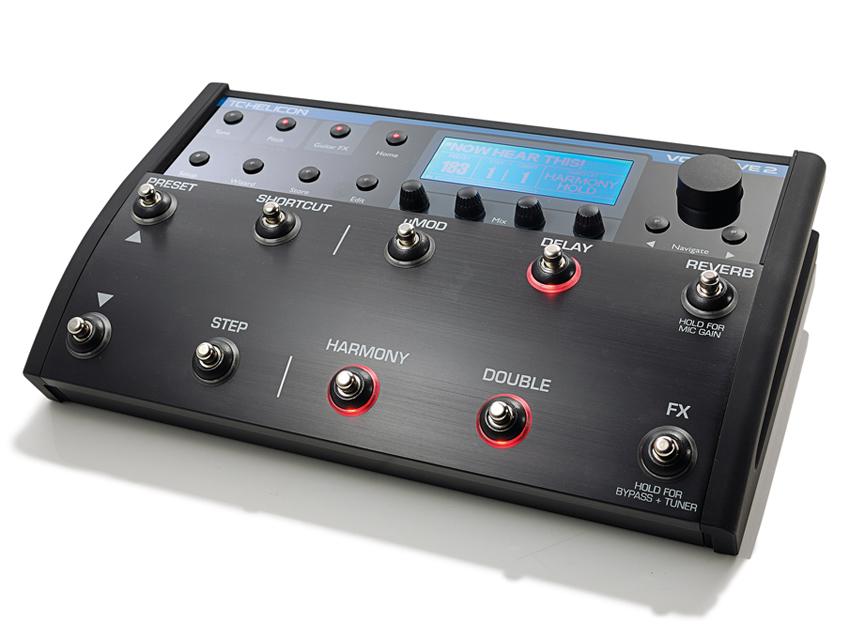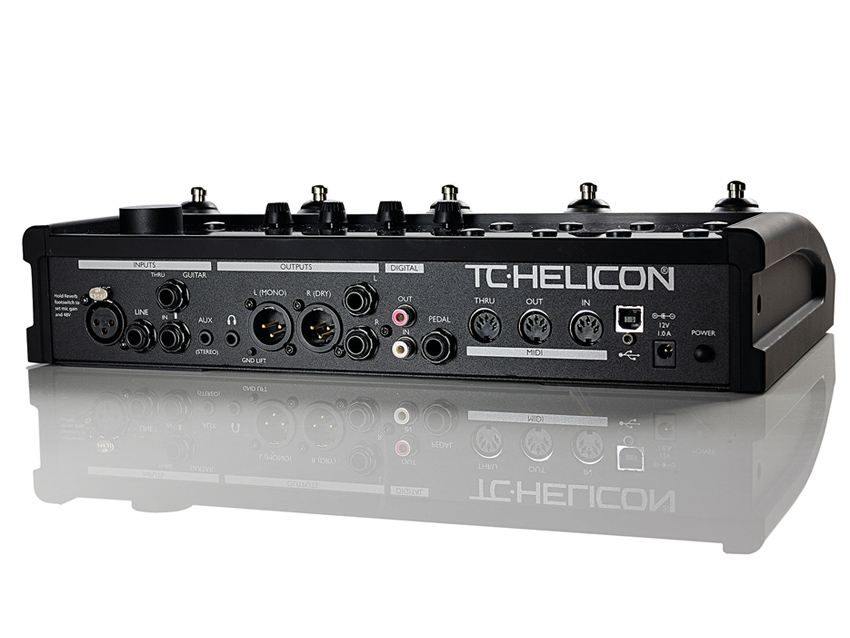MusicRadar Verdict
An inspiring collection of effects designed for, but not limited to, live vocal performance.
Pros
- +
Intelligent harmony creation is a real joy. Huge sophistication. Ease of use.
Cons
- -
None.
MusicRadar's got your back

TC-Helicon VoiceLive 2

TC-Helicon VoiceLive 2
Think of stompbox multi-effects units and you're bound to conjure up an image of a guitarist, slamming down on distortion or fuzz pedals to enhance performance throughout a track.
For some reason, a vocal-targeted equivalent has taken longer to catch on but with artists including Imogen Heap and Björk now reliant on guitar-like real-time processing, it's perhaps no surprise that at least one company has been paying attention.
"VoiceLive 2 works intelligently through tracking and mixing to provide a rich, unique flavour."
It's no surprise that that company is TC-Helicon, if you consider its history in vocal processing. VoiceLive 2 could just revolutionise vocal performances coming soon to a stage near you.
Featuring multi-effects, intelligent on-board algorithms and huge flexibility, this is a processor designed to inspire and delight.
Going live
At the heart of VoiceLive 2 is a collection of real-time effects processors which can be 'stomped' on and off, guitar-style. Each preset or user-created program features up to six of these modules simultaneously and there is real sophistication here, with effects including auto-tune style pitch correction, voice doubling and intelligent Harmonization, of which more shortly.
Additionally, Delay and Reverb modules provide a range of spatial effects to enhance these more obviously 'vocal' algorithms.
The design of VoiceLive 2 is superb - as well as the stomp switches for each effect, foot-controlled preset navigation is offered, as is a Shortcut foot-switch which activates a user-defined parameter for each preset, to allow you to interact with an additional sound control in real-time.
A bright, backlit LCD display at the top keeps you in touch with preset parameters and if you want in-depth editing, this is offered via four rotaries below the screen that correspond to the parameters shown.
The rear panel offers remarkable flexibility, with microphone, line level, guitar and 3.5mm input sources, balanced stereo XLR, line and S/PDIF outputs and MIDI I/O, too.
This means that a range of sound sources can benefit from VoiceLive 2's processors via multiple input types, but there's also a hidden benefit. As the processor auto-detects pitch information from incoming audio signals, if you're a lead singer/guitarist or singer/keyboard player, you can use the output signal from your guitar or MIDI out port to feed VoiceLive 2 the note information it will use to generate harmonies. A performer's dream.
Intelligent harmonies
VoiceLive 2 shows its colours as an inspiring tool the moment you switch it on, as it's extremely simple to use. This is best exemplified by its intelligent Harmonizing engine, which either allows you to select the root scale of your track or to auto-detect it as you perform, offering up to eight Harmonized notes in support of your performance.
Once this information is onboard, VoiceLive 2 neatly side-steps the problems offered by real-time pitch shifters. Normally, these allow you to set up one or more Harmonizations of your input source but with each voice at a fixed semi-tone offset above or below the performed pitch.
VoiceLive 2 is different, as it intelligently detects which note you're singing within a scale and adjusts its harmonies accordingly, so if you're in C major and you sing the root note, you'll be greeted with harmonies appropriate to that chord but if you sing a D, the chord will change to an appropriate minor, as it will when you sing an A.
Similarly, the harmonies produced will jump from thirds to fourths as appropriate to the scale. This is wonderful - we're no singer but we found ourselves jamming away with a huge smile on our face.
Harmonies are supported by the 'Double' module, which provides 'voice thickening' effects by reinforcing your input signal at its original pitch, or providing octave-only harmonisation.
While we're very happy creating harmonies in the studio in Melodyne, VoiceLive 2 provided the first harmonisation capabilities to have really blown us away in the hardware domain, with the huge thrill of real-time operation ,too.
Quality-wise, we'd as happily route a recorded lead vocal into VoiceLive 2 and fly it back in our DAW in studio sessions as we would use this box onstage.
What we like so much is that the unit is geared to let you play with the parameters you'd want but covers so many other bases in the background. So, via the Tone button, for instance, you can set up EQ, compression, de-essing and gating for a preset but then leave these parameters alone, as they'd be unlikely to change during a single song.
If you do want variations to these parameters, simply make them and save them to the next program location, so you can switch easily during a performance.
Heard and not seen
Whereas ten years ago the idea of taking cutting- edge technology onstage seemed brave and risky, now we're positively embracing tools that are as much for use in the heat of live performance as they are in the studio.
VoiceLive 2 fits this description perfectly, allowing you to achieve the kinds of looping effects currently associated with Jamie Lidell, Beardyman and Shlomo plus a whole lot more besides.
While the unit is targeted at real-time performance and therefore suggests itself for live use alone, we'd struggle to think of a more inspiring studio tool, as it will get ideas flowing but also work quickly and intelligently through the tracking and mixing stages to provide a rich, unique flavour.
We'readding one to our own shopping list, and whether you're performing live or looking for a studio processor with a difference, we'd highly recommend checking VoiceLive 2 out.
Future Music is the number one magazine for today's producers. Packed with technique and technology we'll help you make great new music. All-access artist interviews, in-depth gear reviews, essential production tutorials and much more. Every marvellous monthly edition features reliable reviews of the latest and greatest hardware and software technology and techniques, unparalleled advice, in-depth interviews, sensational free samples and so much more to improve the experience and outcome of your music-making.
“Built from the same sacred stash of NOS silicon transistors and germanium diodes, giving it the soul – and snarl – of the original”: An octave-fuzz cult classic returns as Jam Pedals resurrects the Octaurus
What’s the buzz? Meet Yellowjacket, Cherry Audio's recreation of EDP’s trend-setting Wasp from 1978
“A fabulous trip through all eight songs by 24 wonderful artists and remixers... way beyond anything I could have hoped for”: Robert Smith announces new Cure remix album










